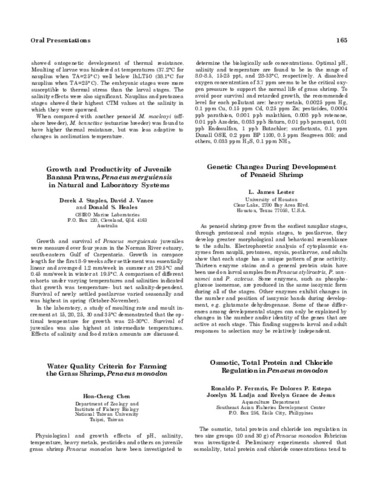Artificial substratum consisting of poly-β-hydroxybutyrate-based biodegradable plastic improved the survival and overall performance of postlarval tiger shrimp Penaeus monodon
- Global styles
- MLA
- Vancouver
- Elsevier - Harvard
- APA
- Help

View/Open
Date
2019Author
Page views
3,812ASFA keyword
AGROVOC keyword
Taxonomic term
Metadata
Perlihat publikasi penuhCited times in Scopus
- Citations
- CrossRef - Citation Indexes: 3
- Policy Citation - Policy Citations: 1
- Scopus - Citation Indexes: 4
- Captures
- Mendeley - Readers: 12
Share
Abstract
The use of artificial substratum consisting of poly‐β‐hydroxybutyrate (PHB)‐based biodegradable plastic for penaeid shrimp culture was investigated in the present study. The survival of postlarval tiger shrimp Penaeus monodon (30 ± 5 mg) provided with PHB substratum made out of PHB type DP9002 (Metabolix GmbH, Köln, Germany) was 88.7 ± 3.4% and this was significantly higher as compared to postlarvae provided conventional substratum consisting of polyvinylchloride (PVC) pipes (67.3 ± 6.5%). However, no significant weight improvement was observed for the postlarval tiger shrimp indicating that PHB could not be used as growth promoter. Nevertheless, a trend of improved robustness against adverse environmental conditions (lethal ammonium chloride concentration) and increased resistance to pathogenic Vibrio was observed in postlarval tiger shrimp provided with PHB substratum as compared to postlarvae provided with PVC substratum. Results indicate higher preference by postlarvae on PHB substratum over PVC substratum. Overall, this study indicates the potential of artificial substratum consisting of PHB‐based biodegradable plastic as replacement for conventional substratum consisting of PVC pipes in enhancing the survival of postlarval tiger shrimp and improving its performance against adverse environmental conditions and disease resistance.
Suggested Citation
Ludevese-Pascual, G., Laranja, J. L., Amar, E., Bossier, P., & De Schryver, P. (2019). Artificial substratum consisting of poly-β-hydroxybutyrate-based biodegradable plastic improved the survival and overall performance of postlarval tiger shrimp Penaeus monodon. Aquaculture Research , 50(4), 1269-1276. https://doi.org/10.1111/are.14003
Type
ArticleISSN
1355-557X; 1365-2109Koleksi
- Journal Articles [1247]
Related items
Showing items related by title, author, creator and subject.
-
Effect of salinity on the osmotic, chloride, total protein and calcium concentrations in the hemolymph of the prawn Peneaus monodon (Fabricius)
Ferraris, Ronaldo P.; Parado-Estepa, Fe D.; Ladja, Jocelyn M.; de Jesus, Evelyn G. (Elsevier, 1986)1. Osmolality and chloride concentrations in the hemolymph of Penaeus monodon became stable 1 day after molting in 32 ppt, while total protein and calcium concentrations remained stable throughout the molting cycle. When ...6969 Total citations2 Recent citationsn/a Field Citation Ration/a Relative Citation Ratio -
Osmotic, total protein and chloride regulation in Penaeus monodon
Ferraris, Ronaldo P.; Estepa, Fe Dolores P.; Ladja, Jocelyn M.; de Jesus, Evelyn Grace (Aquaculture Department, Southeast Asian Fisheries Development Center, 1985)The osmotic, total protein and chloride ion regulation in two size groups (10 and 30 g) of Penaeus monodon Fabricius was investigated. Preliminary experiments showed that osmolality, total protein and chloride concentrations ... -
Osmotic and chloride regulation in the hemolymph of the tiger prawn Penaeus monodon during molting in various salinities
Ferraris, Ronaldo P.; Parado-Estepa, Fe D.; de Jesus, Evelyn Grace; Ladja, Jocelyn M. (Springer Verlag, 1987)The effect of molting on osmotic and chloride concentrations in the blood of the prawn Penaeus monodon Fabricius (20±3 g) at various salinities was investigated. Prawns were obtained from ponds in Iloilo, Philippines, in ...4242 Total citations2 Recent citationsn/a Field Citation Ration/a Relative Citation Ratio







